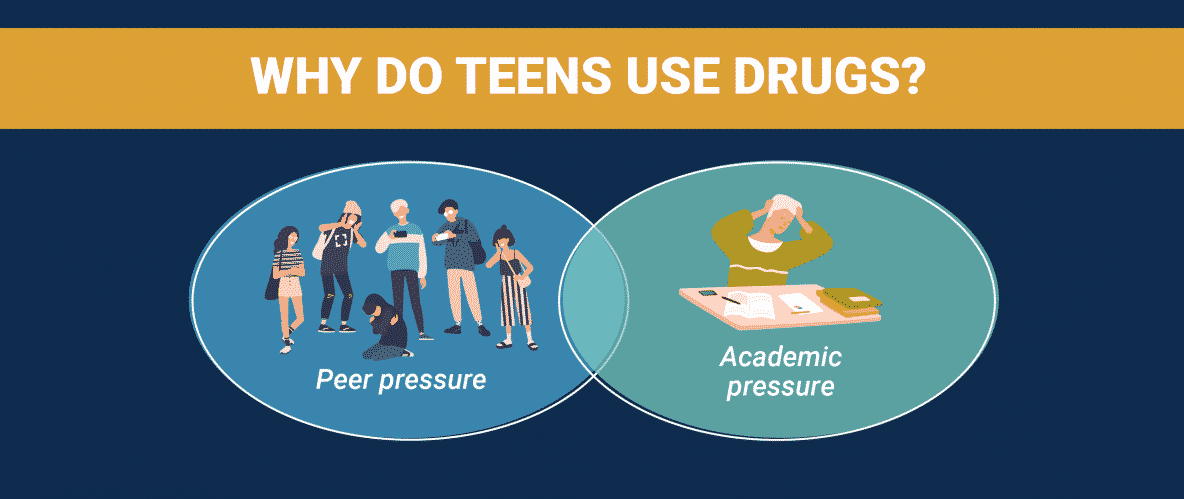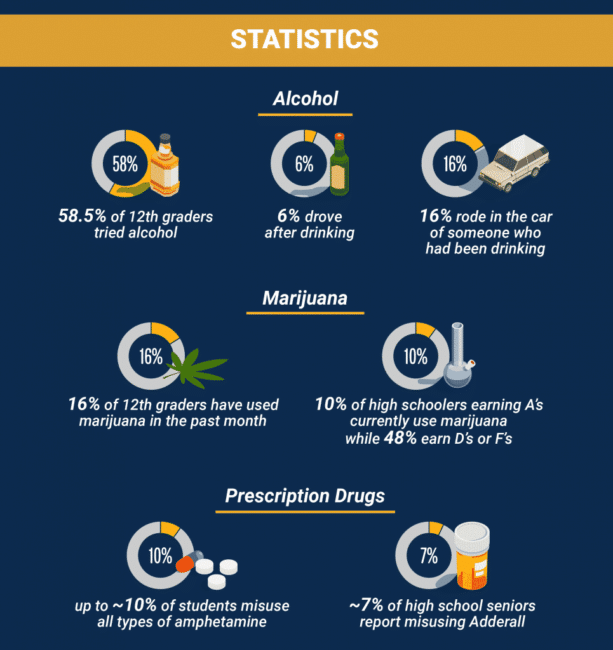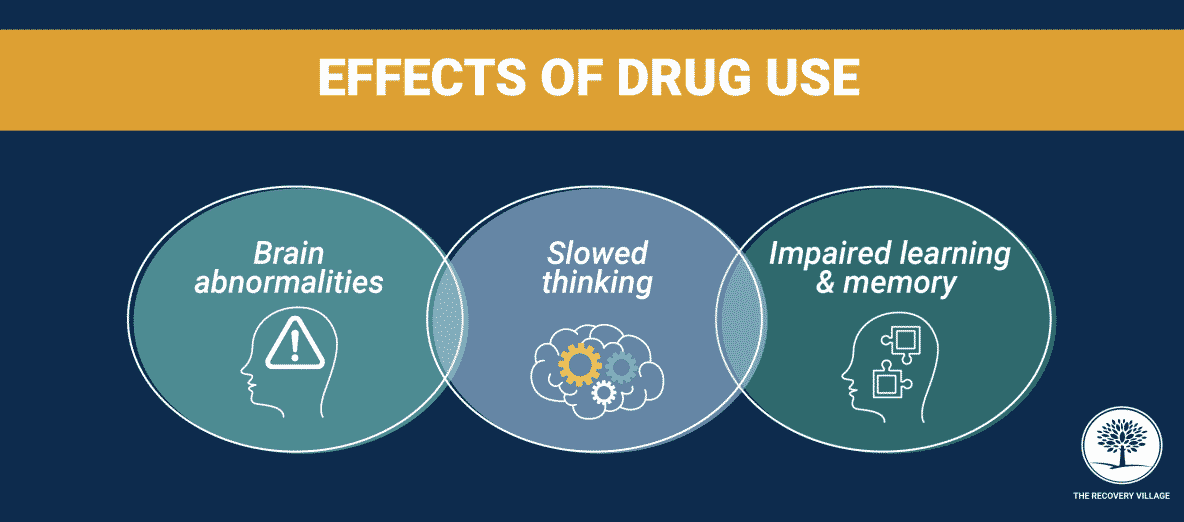High school is where many teenagers encounter drugs and alcohol for the first time. Read about the latest facts and statistics on adolescent substance use here.
Teenagers might enter high school as children, but they graduate as young adults. This four-year period is transformational — full of growth, hardships and self-discovery. It’s also an experimental time, and for millions of teens, that means trying drugs and alcohol.
The availability of drugs at school is surprisingly high, especially in high school. Sadly, some teens using drugs will suffer serious consequences as a result of their substance use. This article highlights teenage drug usage statistics and what factors influence the prevalence of drugs in school settings.
Article at a Glance:
- Teens often experiment with drug use due to peer pressure and academic pressure.
- Approximately 20 percent of high school students have had an encounter with drugs on school property.
- High school students use alcohol more than any other illicit drug.
- Using drugs during the teenage years can have severe and long-lasting effects.
- The Recovery Village offers help for teenagers who are misusing alcohol or drugs.
- Why Do Teens Use Drugs?
Why Do Teens Use Drugs?
There are many different possible causes of teen drug use. Many are reacting to peer pressure and believe that turning to drugs and alcohol is how to become popular in high school. Some use drugs to self-medicate from painful feelings.
Some teens even turn to “study aid” drugs like Adderall or Ritalin, because they believe these substances will boost their academic performance. High school is often the first time that kids encounter illicit substances, and their curiosity often gets the better of them.

Peer Pressure
Peer pressure is influence from the people in one’s social group or setting. Not all peer pressure is bad, though. This influence can cause people to act more responsibly or join a sports team, for example. However, usually, when peer pressure is discussed, it is negative and often is tied to bullying.
Teens face an overwhelming amount of peer pressure in high school, from their classmates and friends. Peer pressure during adolescence often involves risky behaviors, such as trying drugs or alcohol. Teenagers may feel as though they need to give in to this pressure to fit in socially.
Academic Pressure
High school is an exceptionally busy and stressful period of life, and academic pressure in high school is very high. Students face harder classes and are gearing up to go to college or start a career. The pressure to get good grades, do well on entrance exams and succeed in extracurricular activities comes from both parents and teachers.
Overwhelmed by homework and studying, teens sometimes turn to performance-enhancing drugs to boost their energy and concentration. They might also take drugs to help them sleep better under stress. Taken without a prescription, these drugs can become addictive and can cause dangerous health effects.
Teenage Drug Use Statistics
Though not all teens abuse drugs or alcohol, most teenagers know somebody who does. Drug prevalence and availability is high as well. The latest statistics show that nearly 20% of high school students have been offered, sold or given drugs, on school property, in the past year. Fortunately, the fact is that drug use among teenagers is declining: a recent study found that 4.3% of high schoolers had used drugs in the month before being surveyed, which is lower than drug usage statistics from previous years.

Teen Alcohol Use Statistics
In the United States, high school students abuse alcohol more than any illicit drug. Not surprisingly, it causes the most harm, and underage alcohol use is responsible for potentially losing 225,000 years of life and 3,900 deaths each year among people under the age of 21.
Statistics from surveys conducted the past two years show:
- 25.8% of 12th graders had tried alcohol (2021 study)
- 29% of high schoolers drank in the last month
- 14% binge drank (consuming four or more alcoholic beverages in a row)
- 17% rode in the car of someone who had been drinking
- 5% drove after drinking
Teenage Marijuana Use Statistics
In terms of illicit drugs, teenagers abuse marijuana the most. With the legalization of marijuana and cannabis products in many states, marijuana is now easily accessible to many high school students. At the same time, teenage perception of the dangers associated with marijuana use or the risk of marijuana addiction has decreased. Marijuana use in teens has remained steady in recent years, though many teens are now vaping marijuana in addition to smoking it.
Current and even past marijuana use is linked to significantly lower academic performance. The statistics on teenage marijuana use show that middle and high school marijuana use is common:
- 19.5% of 12th graders have used marijuana in the past month
- 4.1% of 8th graders have used marijuana in the past month
- 10% of high schoolers earning As as grades currently use marijuana, as opposed to 48% of those earning Ds or Fs
Prescription Drug Statistics
Fortunately, the opioid epidemic seems to have avoided high schools. Unlike adults in the country, non-medical use of prescription drugs, especially opiate painkillers, has decreased among teenagers in recent years. About 11% of high school seniors report misusing prescription medications in the past year. However, the number is only 6.8% when it comes to the misuse of painkillers specifically.
Academic pressure and lack of sleep can cause teens to turn to drugs to boost their performance in school. Stimulants, like the amphetamine drugs Adderall and methylphenidate (Ritalin) are often chosen by students trying to cram for an exam or staying up late finishing homework. While these are often prescribed to treat attention-deficit hyperactivity disorder (ADHD), they can cause harmful health effects if not used properly. They can also become addictive.
According to a 2021 survey:
- 1.8% of high school seniors reported misusing Adderall over a 12 month period
- 2.3% of high school seniors reported misuse any type of amphetamine over a 12 month period
Other Drugs Used by High Schoolers
Nearly a quarter of American high schoolers use at least one type of illicit drug. Many use more than one, or combine them with alcohol or tobacco. Common drugs used by teenagers (besides marijuana) include:
- Amphetamines
- Cough medicine
- Hallucinogens
- Ecstasy (MDMA)
- LSD
- Cocaine
- Inhalants
- Salvia
Teenage Drug Use Effects
Using drugs, alcohol or tobacco in high school can cause severe long-term effects. Trying any of these before the age of 21 significantly raises the risk of developing an addiction or drug dependence.

Consequences of addiction to any substance include:
- Brain abnormalities
- Slowed thinking
- Impaired learning and memory issues
Drug abuse can also deplete the brain of certain chemicals like dopamine and serotonin, sending high schoolers into a prolonged depression and leaving them susceptible to more destructive behaviors. Furthermore, teen substance abuse of any kind can have a major negative impact on their academic performance.
Does Your Teenager Need Addiction Treatment?
If you notice any signs of addiction in your teen, now is the time to reach out to a professional. There is help for teenagers who are misusing drugs or alcohol, but the longer the substance abuse continues, the harder it will be for your child to recover over the long-term.
Your family doctor or your child’s pediatrician can help you determine the best course of action, and whether you should begin looking into substance abuse treatment options. Depending on the severity of addiction, they might encourage inpatient or outpatient drug rehab. At that point, you’ll need to look into insurance for rehab and any possible out-of-pocket costs of drug rehab treatment.
At The Recovery Village, we can help you sort through all the details of teen rehab, confidentially. You are not alone, and there is hope for your teen. Call The Recovery Village today to speak with a caring representative.


Glossary of Dabbing Terms
The Centers for Disease Control and Prevention. “Youth Online: High School YRBS – 2019 Results“>Youth On[…] 2019 Results.” 2019. Accessed July 28, 2022.
Debnam, Katrina; Saha, Shonali; Bradshaw, Catherine. “Synthetic and Other Drug Use among High School Students: The Role of Perceived Prevalence, Access, and Harms“>Syntheti[…]ss, and Harms.” Substance Use & Misuse, 2018. Accessed June 21, 2019.
The Centers for Disease Control and Prevention. “Fact Sheet: Underage Drinking“>Fact She[…]rage Drinking.” August 2, 2018. Accessed July 28, 2022.
McCabe, S. et al. “ Sources of Nonmedical Prescription Drug Misuse Among US High School Seniors: Differences in Motives and Substance Use Behaviors.“Journal of the American Academy of Child & Adolescent Psychiatry, July 1, 2019. Accessed July 28, 2022.
National Center for Educational Statistics. “Students’ Peer Groups in High School: The Pattern and Relationship to Educational Outcomes“>Students[…]onal Outcomes.” June 1997. Accessed July 28, 2022.
The National Institute on Drug Abuse. “Drugs, Brains, and Behavior: The Science of Addiction: Drug Misuse and Addiction“>Drugs, B[…]and Addiction.” July 2020. Accessed July 28, 2022.
The National Institute on Drug Abuse. “Drugs, Brains, and Behavior: The Science of Addiction: Drugs and The Brain.“>Drugs, B[…]nd The Brain.” July 2020. Accessed July 28, 2022.
The National Institute on Drug Abuse. “Monitoring the Future Survey: High School and Youth Trends“>Monitori[…] Youth Trends.” December 2020. Accessed July 28,2022.
The National Institute on Drug Abuse. “What drugs are most frequently used by adolescents?” January 2014. Accessed July 28, 2022.
The National Institute on Drug Abuse. “Why Do Adolescents Take Drugs?” January 2014. Accessed July 28, 2022.
Pew Research Center. “Most U.S. Teens See Anxiety and Depression as a Major Problem Among Their Peers“>Most U.S[…]g Their Peers.” February 20, 2019. Accessed July 28.2022.
Schuler, Megan; Tucker, Joan; Pedersen, Eric; D’Amico, Elizabeth. “Relative influence of perceived peer and family substance use on adolescent alcohol, cigarette, and marijuana use across middle and high school.” Addictive Behaviors, January 2, 2019. Accessed June 21, 2019.
The Centers for Disease Control and Prevention. “Alcohol and Other Drug Use and Academic Achievement“>Alcohol […]c Achievement.” Accessed June 21, 2019.
McCabe SE, et al. “Sources of Nonmedical Prescription Drug Misuse Among United States High School Seniors: Differences in Motives and Substance Use Behaviors“>Sources […]Use Behaviors.” Journal of the American Academy of Child and Adolescent Psychiatry, March 27, 2019. Accessed June 21, 2019.
Palamar, Joseph J.; Le, Austin. “Discordant reporting of non-medical amphetamine use by Adderall-using high school seniors in the US“>Discorda[…]ors in the US.” Drug and Alcohol Dependence, October 20, 2017. Accessed June 21, 2019.
Chen, Lian-Yu, et al. “Patterns of concurrent substance use among adolescent nonmedical ADHD stimulant users“>Patterns[…]imulant users.” Addictive Behaviors, May 15, 2015. Accessed June 21, 2019.
The Recovery Village aims to improve the quality of life for people struggling with substance use or mental health disorder with fact-based content about the nature of behavioral health conditions, treatment options and their related outcomes. We publish material that is researched, cited, edited and reviewed by licensed medical professionals. The information we provide is not intended to be a substitute for professional medical advice, diagnosis or treatment. It should not be used in place of the advice of your physician or other qualified healthcare providers.